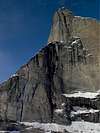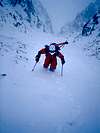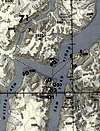|
|
Mountain/Rock |
|---|---|
|
|
70.81000°N / 68.39°W |
|
|
4717 ft / 1438 m |
|
|
Overview
Polar Sun Spire has been called 'the mother of all headwalls' and is reputed to be an even larger uninterrupted cliff face than that which is found on Mt. Thor (which I submitted a few weeks ago). The cliff face is a full 1300 meters or more and was only just recently climbed in 1996 by a joint team from Canada and the U.S.
The entire region is home to massive headwalls... even more so than Auyuittuq... which I find difficult to fathom. There are 10 walls 1000m or higher and reputedly dozens with uninterrupted faces 600 meters or higher. It is a climbers and trekkers paradise.
Polar Sun Spire is located on the western coast of the central section of Baffin Island. The closest town in a small Inuit settlement called Clyde River which is a 3-5 day walk or a full 1 hour flight away. Most of the cliffs are found along the shore of two fjords or inlets known as Sam Ford Inlet and Stewart Valley. Unlike the peaks in Auyuittuq, Polar Sun Spire isn't located within the confines of a National Park so there are no additional fees to pay other than the egregious ones incurred from simply outfitting and getting there.
The first ascent occurred in 1996. The three men who climbed her were Mark Synnott (the team leader), Jeff Chapman and Warren Hollinger. The climb was an epic struggle. The team spent 39 days putting up the route, of which 36 nights were spent bivvying on porta-ledges. The face is on the north wall and is a grade VII route (one of a very few in Canada) that consists of 34 pitches and has been dubbed 'The Great and Secret Show' in honour to Clive Barker.
In 2000 the Norwegians pioneered a new route up which is a grade VI climb and took them close to four weeks to accomplish. Any climb of this wall/peak is a serious undertaking for only the most tested climber. There does seem to be simpler routes to the summit and if and when I get a hold of that information I will pass it on.
The area is also popular for base jumpers and skiers who like to ski the narrow, virgin couloirs unlike those that can be found anywhere else on earth. From the pictures I've seen the couloirs are unbelievably narrow, the kind where one mistake and you're time on this earth is at an end.
The inlets stay frozen virtually (except for a breif respite in late July-August) year-round and as a result there are far fewer animals that one may encounter during a visit. If entering into the Stewart Valley you may encounetr caribou, arctic fox and hares... otherwise the only animals you are likely to see are seals and polar bears.
Getting There
Again like Barbeau peak and the peaks from Auyuittuq this is the most difficult part of the journey... and of course the most expensive. Flights originate in Montreal and may require a stopover in Pangnirtung or Iqaluit before continuing onwards up to Clyde River. Clyde River is about 400- 450km north of Auyuittuq.
From Clyde River the journey is either made by sled or boat into Sam Ford Inlet depending on how frozen the ocean is around Clyde River. The journey can be done in 2 long days or 3-4 days... as per usual entirely dependent on mother nature.
Polar Sun Spire is located on the eastern shore of Sam Ford Inlet and around are other spectacular walls like Kiguti Peak, Great Sail Peak and Walker Spire... 2 of which contain walls in excess of 1000 meters and the other a mere 750.
The spire has been climbed only a handfull of times as the headwall is one of the most severe challenges on earth for climbers... so information is scanty at best. The best time to climb is a six to seven week window which stretches from the second half of July to the end of August.
Once in Clyde River, Quillukkut Guides and Outfitters are the only agency that can outfit a group for the needs of an expedition. The Outfitters is run by local inuits (a husband and wife) who are more than eager to help in any way they can and will go well beyond what is called for to make visitors feel welcome.
Red Tape
Again the most difficult part is simply getting there. As far as I know there is no permits required to visit the area... the $5000 investment most will already be making is investment enough I am sure.
The only real time to climb is duing the latter half of May through to the middle of July. I am sure it is possible to dog sled through the area in April or May. The weather though is far different than it is in later in Spring and during the first few weeks of summer. In April temperatures can average between -15 and -25 celsius... quite inhospitable...while in June and July it is somewhat inviting with daytime highs approaching 10-12.
When To Climb
The only time to really climb is from mid May to mid July before the pack ice breaks up... becasue after that the fjords and inlets become impassable.
It is perhaps possible to climb some of the smaller walls earlier in the spring but the cold, the wind and the storms would make this more of a herculean task... battling the Spire itself is difficult enough without factoring in the weather.
Camping
Camping is allowed... there are no specific spots allotted its simply pickwhatever spot you think is best and settle in for the night. Be careful of camping directly beneath any of the cliffs as like the peaks in Auyuittuq large rock falls are a regular daily event.
Again always follow the rule of packing out what you bring in as the area is a remarkably unspoiled Arctic environment.
Mountain Conditions
For weather conditions you can check two places. Firstly as always the www.theweathernetwork.com will have hourly updates on the local conditions plus a five day forecast.
You can also check www.wunderground.com/global/stations/71090.html which seems to provide even more accurate up to the minute details. Other than that the Outfitters will probaby be able to provide you with an idea as to waht to expect weather wise during your visit.


















